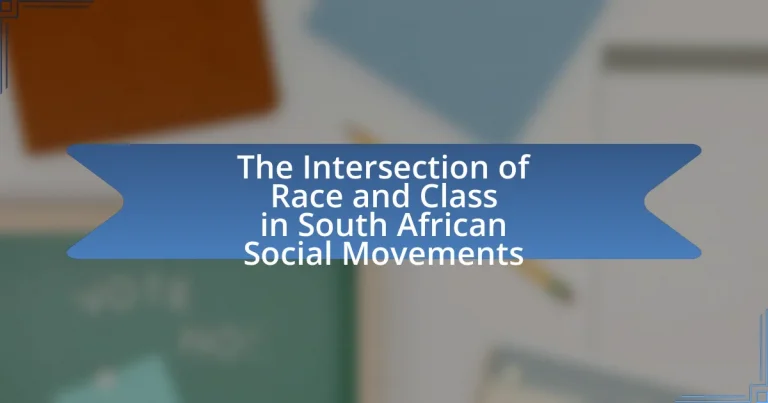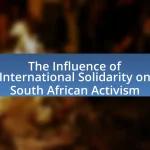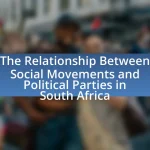The article examines the intersection of race and class within South African social movements, highlighting how these two factors influence socio-economic disparities and activism. It discusses the historical context of apartheid, which entrenched racial inequalities and economic disparities, and how contemporary movements like Fees Must Fall reflect the ongoing struggles against these injustices. The article also explores the complexities of race and class interactions, the challenges faced by social movements, and the implications for policy-making and grassroots activism, emphasizing the need for inclusive strategies that address systemic inequalities. Key movements such as the Anti-Apartheid Movement and the Black Consciousness Movement are analyzed to illustrate the intertwined nature of race and class in the fight for social justice in South Africa.
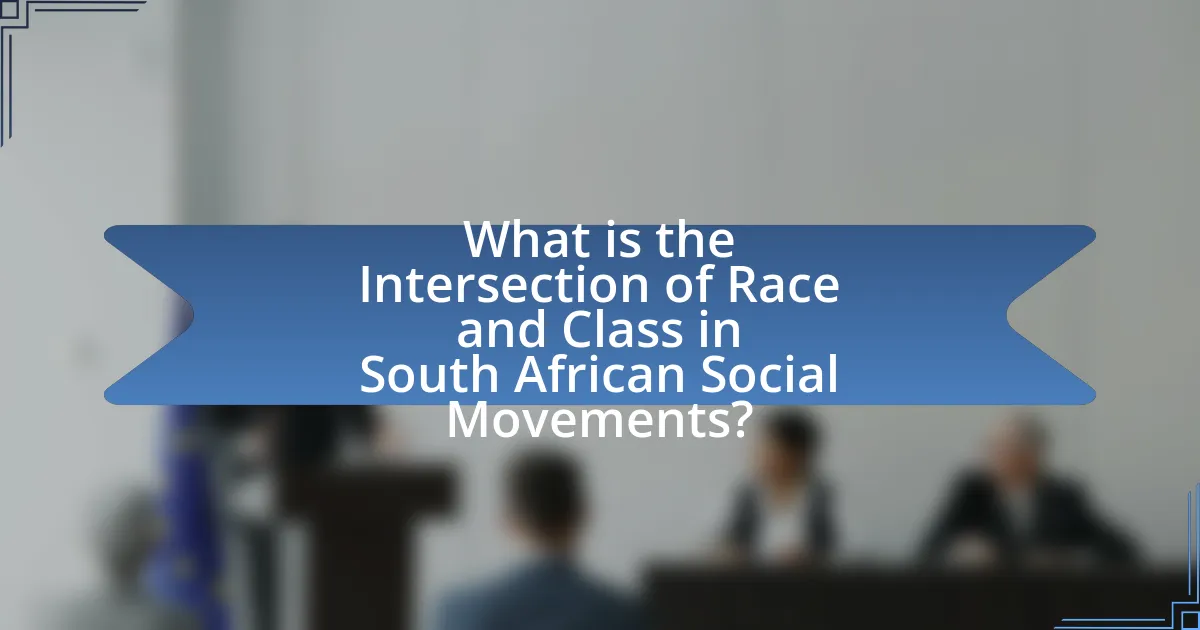
What is the Intersection of Race and Class in South African Social Movements?
The intersection of race and class in South African social movements reveals a complex relationship where racial identity significantly influences class struggles and vice versa. Historically, the apartheid system entrenched racial inequalities, leading to socio-economic disparities that persist today, as evidenced by the high unemployment rates among Black South Africans, which stood at approximately 34% in 2021, compared to 7% for white South Africans. Social movements, such as the Fees Must Fall campaign, illustrate how race and class intersect, as they mobilized predominantly Black students advocating for affordable education while highlighting the broader socio-economic injustices rooted in both race and class disparities. This intersectionality is crucial for understanding the dynamics of activism in South Africa, as it shapes the goals, strategies, and experiences of various social movements.
How do race and class interact within the context of South African social movements?
Race and class interact significantly within South African social movements, as both factors shape the experiences and mobilization strategies of individuals and groups. Historically, the apartheid system entrenched racial divisions and economic disparities, leading to social movements that often addressed both racial injustice and class inequality. For instance, the anti-apartheid movement, led by organizations such as the African National Congress, highlighted the intersectionality of race and class by advocating for the rights of black South Africans who faced systemic oppression and economic marginalization. Research by scholars like Ashwin Desai in “We Are the Poors: Community Struggles in Post-Apartheid South Africa” illustrates how social movements often mobilize around issues that reflect both racial identity and class struggles, emphasizing that the fight for economic justice cannot be separated from the fight against racial discrimination. This interconnectedness continues to influence contemporary movements, such as the Fees Must Fall campaign, which addresses both educational access and the socio-economic barriers faced by black students.
What historical factors have shaped the intersection of race and class in South Africa?
The intersection of race and class in South Africa has been shaped primarily by colonialism, apartheid, and economic policies. Colonialism established racial hierarchies and land dispossession, which marginalized Black South Africans and created economic disparities. The apartheid regime, enforced from 1948 to the early 1990s, institutionalized racial segregation and discrimination, severely restricting the rights of non-white populations and limiting their access to quality education, employment, and housing. This systemic inequality entrenched class divisions along racial lines, with the majority of wealth and resources concentrated in the hands of the white minority. Economic policies post-apartheid, such as neoliberal reforms, have further complicated this intersection by failing to adequately address historical injustices, resulting in persistent economic inequality and social stratification based on race.
How do contemporary social movements reflect the complexities of race and class?
Contemporary social movements in South Africa reflect the complexities of race and class by addressing systemic inequalities that disproportionately affect marginalized communities. These movements, such as the Fees Must Fall and Black Lives Matter South Africa, highlight how economic disparities intersect with racial discrimination, revealing that issues of access to education and economic opportunities are often rooted in historical injustices. For instance, the Fees Must Fall movement emerged in response to the rising costs of higher education, which disproportionately impacted black and working-class students, illustrating the direct link between class struggles and racial identity. Additionally, research by the South African Institute of Race Relations indicates that black South Africans are more likely to experience poverty, further complicating the dynamics of race and class within these movements.
Why is understanding this intersection important for social justice?
Understanding the intersection of race and class is crucial for social justice because it reveals how systemic inequalities are interconnected and perpetuated in society. In South Africa, historical contexts such as apartheid have entrenched racial and economic disparities, leading to marginalized communities facing compounded disadvantages. Research by the South African Human Sciences Research Council indicates that individuals from lower socioeconomic backgrounds, particularly those from racially marginalized groups, experience higher rates of poverty and limited access to education and healthcare. This intersectional understanding allows social movements to address the root causes of inequality, advocate for equitable policies, and mobilize diverse communities effectively, ultimately fostering a more inclusive society.
What implications does the intersection of race and class have for policy-making?
The intersection of race and class significantly influences policy-making by shaping the priorities and perspectives of policymakers. In South Africa, historical inequalities rooted in apartheid continue to affect socio-economic conditions, leading to policies that may inadequately address the needs of marginalized communities. For instance, research by the South African Institute of Race Relations indicates that economic disparities persist along racial lines, with black South Africans facing higher unemployment rates and lower access to quality education. This intersection necessitates that policymakers consider both racial and class dimensions to create equitable solutions that address systemic injustices and promote social cohesion.
How can this understanding influence grassroots activism?
Understanding the intersection of race and class in South African social movements can significantly influence grassroots activism by fostering more inclusive and targeted strategies. This understanding allows activists to recognize the unique challenges faced by marginalized communities, enabling them to tailor their approaches to address specific needs and grievances. For instance, research by the South African Human Sciences Research Council indicates that social movements that effectively integrate both race and class considerations tend to mobilize broader support and achieve more substantial policy changes. By acknowledging these intersections, grassroots activists can build coalitions that unite diverse groups, enhancing their collective power and impact.
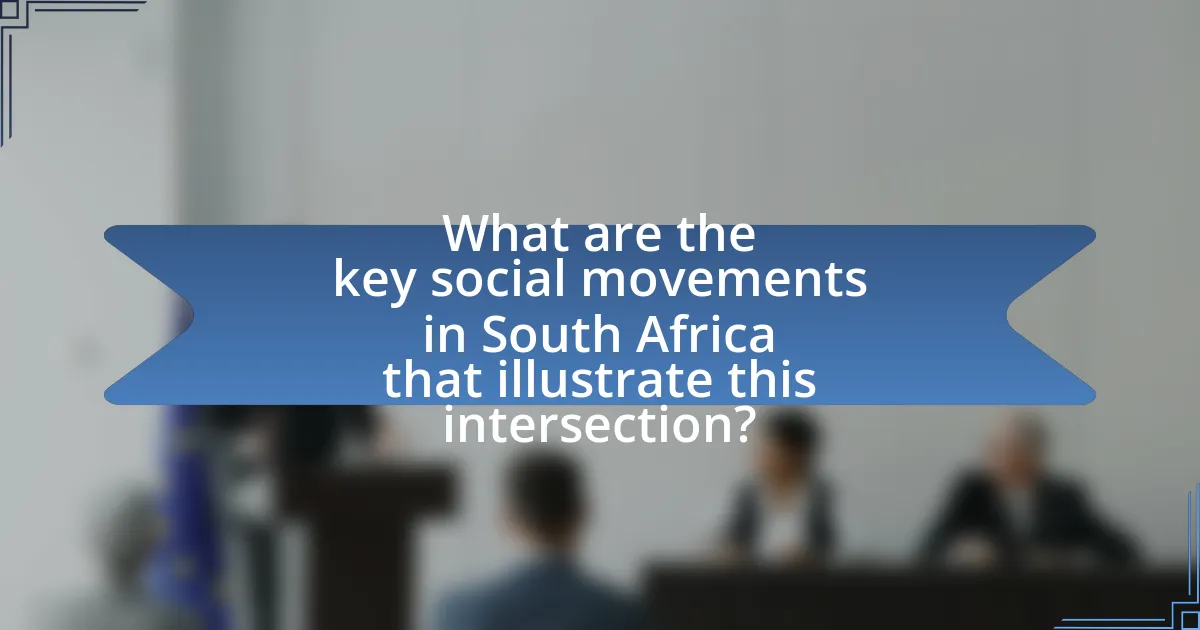
What are the key social movements in South Africa that illustrate this intersection?
Key social movements in South Africa that illustrate the intersection of race and class include the Anti-Apartheid Movement, the Black Consciousness Movement, and the Fees Must Fall Movement. The Anti-Apartheid Movement, which gained momentum in the 1980s, united various racial and class groups against institutionalized racial segregation, highlighting the economic disparities faced by black South Africans. The Black Consciousness Movement, led by figures like Steve Biko, emphasized black identity and empowerment, addressing both racial oppression and class struggles. The Fees Must Fall Movement, which began in 2015, focused on the financial barriers to higher education, disproportionately affecting black and working-class students, thereby linking economic access to racial inequality. These movements collectively demonstrate how race and class intersect in the struggle for social justice in South Africa.
Which movements have prominently featured issues of race and class?
The movements that have prominently featured issues of race and class in South Africa include the African National Congress (ANC), the Black Consciousness Movement (BCM), and the Economic Freedom Fighters (EFF). The ANC, which led the struggle against apartheid, focused on dismantling racial segregation while addressing economic inequalities faced by black South Africans. The BCM emphasized black identity and self-reliance, advocating for the empowerment of black individuals in both social and economic spheres. The EFF, founded in 2013, continues to challenge systemic inequalities, advocating for land redistribution and economic justice for marginalized communities. These movements illustrate the intertwined nature of race and class issues in South Africa’s socio-political landscape.
What role did the anti-apartheid movement play in shaping these dynamics?
The anti-apartheid movement played a crucial role in shaping the dynamics of race and class in South African social movements by uniting diverse groups against systemic racial oppression. This movement mobilized individuals across various socio-economic backgrounds, fostering solidarity among black South Africans and their allies, which challenged the entrenched class hierarchies upheld by apartheid policies. The movement’s strategies, including mass protests, international advocacy, and grassroots organizing, highlighted the intersectionality of race and class, demonstrating how economic disparities were exacerbated by racial discrimination. For instance, the formation of the African National Congress (ANC) and its alliances with labor unions and other organizations illustrated the collective struggle against both racial and economic injustices, ultimately leading to the dismantling of apartheid in the early 1990s.
How do current movements like #FeesMustFall address race and class issues?
Current movements like #FeesMustFall address race and class issues by advocating for equitable access to higher education, which disproportionately affects marginalized racial and economic groups in South Africa. The movement highlights how financial barriers to education reinforce systemic inequalities, as students from historically disadvantaged backgrounds often face insurmountable debt and limited opportunities. For instance, a 2015 report by the South African Human Sciences Research Council indicated that black students are significantly underrepresented in universities due to financial constraints, illustrating the intersection of race and class in educational access. By demanding the abolition of tuition fees and increased government funding for education, #FeesMustFall seeks to dismantle these barriers and promote social justice.
How do different communities perceive the intersection of race and class?
Different communities perceive the intersection of race and class as a complex interplay that shapes social dynamics and inequalities. In South Africa, for instance, historically marginalized racial groups often view class disparities as deeply intertwined with racial discrimination, stemming from apartheid policies that enforced economic and social segregation. Research by the South African Human Sciences Research Council indicates that Black communities frequently experience both racial and economic disadvantages, leading to a perception that class mobility is hindered by systemic racism. Conversely, some affluent communities may perceive race and class as separate issues, focusing on economic factors while downplaying the historical context of racial oppression. This divergence in perception highlights the need for inclusive dialogue that addresses both race and class to foster social cohesion and equity.
What are the perspectives of marginalized communities on social movements?
Marginalized communities view social movements as essential tools for advocating their rights and addressing systemic inequalities. These communities often perceive social movements as platforms for amplifying their voices, challenging oppressive structures, and seeking justice. For instance, in South Africa, the #FeesMustFall movement highlighted the struggles of students from disadvantaged backgrounds, emphasizing the intersection of race and class in access to education. This movement demonstrated how marginalized groups utilize social movements to confront socio-economic barriers and demand equitable policies.
How do socioeconomic factors influence participation in these movements?
Socioeconomic factors significantly influence participation in South African social movements by determining individuals’ access to resources, education, and social networks. Individuals from lower socioeconomic backgrounds often face barriers such as limited financial resources, which restrict their ability to engage in activism, attend meetings, or mobilize effectively. For instance, research indicates that economic instability can lead to decreased participation in movements due to the prioritization of immediate survival needs over activism. Additionally, educational disparities affect awareness and understanding of social issues, further impacting engagement levels. A study by the Institute for Justice and Reconciliation highlights that communities with higher poverty rates exhibit lower participation in social movements, as individuals are often preoccupied with daily struggles rather than collective action.
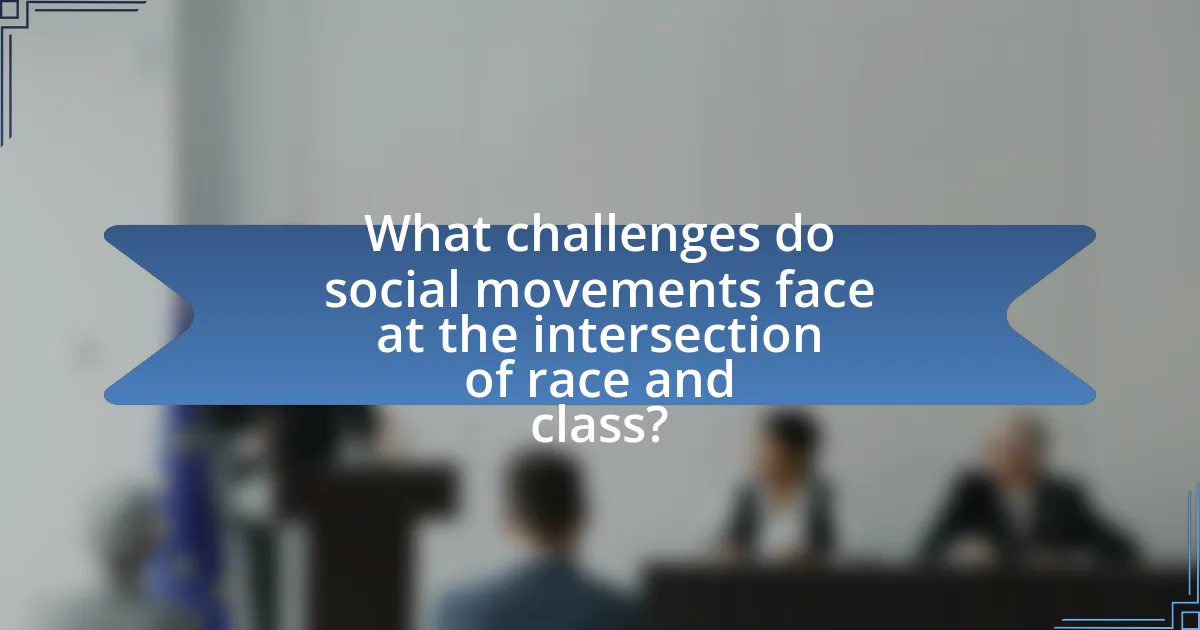
What challenges do social movements face at the intersection of race and class?
Social movements at the intersection of race and class face significant challenges, including systemic inequality, resource disparities, and internal divisions. Systemic inequality manifests through historical injustices that disproportionately affect marginalized racial groups, limiting their access to economic opportunities and political power. Resource disparities hinder the ability of these movements to mobilize effectively, as lower-income communities often lack funding, organizational support, and media representation. Internal divisions arise from differing priorities and experiences within racial and class groups, complicating coalition-building efforts. For instance, the South African social movements have struggled with these issues, as evidenced by the ongoing tensions between various factions advocating for economic justice and racial equality, which can dilute their collective impact.
What internal conflicts arise within movements regarding race and class?
Internal conflicts within movements regarding race and class often manifest as tensions between different racial and socioeconomic groups, leading to disagreements over priorities and strategies. For instance, in South African social movements, there can be a divide between middle-class activists advocating for reform and working-class individuals seeking immediate economic relief. This conflict is evident in the debates surrounding the Economic Freedom Fighters (EFF) and their approach to land redistribution, where differing perspectives on race and class impact unity and effectiveness. Additionally, historical grievances related to apartheid exacerbate these tensions, as marginalized communities may feel that their specific needs are overlooked in favor of broader racial narratives. Such internal conflicts can hinder collective action and dilute the overall goals of the movement.
How do leadership dynamics reflect issues of race and class?
Leadership dynamics in South African social movements often reveal significant disparities related to race and class, as these factors influence who holds power and how decisions are made. For instance, predominantly white leadership in historical movements like the anti-apartheid struggle often marginalized voices from black communities, reflecting systemic inequalities. Research indicates that leadership roles are frequently occupied by individuals from higher socio-economic backgrounds, which can perpetuate class-based exclusions within movements advocating for racial equality. This dynamic is evident in organizations such as the Economic Freedom Fighters, where leadership has been critiqued for not adequately representing the diverse socio-economic backgrounds of their constituents. Thus, the intersection of race and class in leadership roles shapes the effectiveness and inclusivity of social movements in South Africa.
What are the barriers to coalition-building among diverse groups?
Barriers to coalition-building among diverse groups include differing priorities, communication challenges, and historical mistrust. Diverse groups often have unique goals shaped by their specific social, economic, and cultural contexts, which can lead to conflicting interests and priorities. Communication barriers arise from language differences and varying cultural norms, making it difficult to establish a common understanding. Additionally, historical mistrust stemming from past injustices can hinder collaboration, as groups may be wary of each other’s intentions. These factors collectively impede the formation of effective coalitions in social movements, particularly in the context of South Africa, where race and class dynamics play a significant role in shaping group interactions.
How do external factors impact the effectiveness of these movements?
External factors significantly impact the effectiveness of social movements in South Africa by shaping public perception, resource availability, and political response. For instance, media coverage can amplify or diminish the visibility of a movement, influencing public support and engagement. Additionally, economic conditions, such as unemployment rates, can either mobilize individuals to join movements or hinder participation due to financial constraints. Political factors, including government policies and law enforcement responses, can also determine the level of repression or support that movements face, affecting their ability to achieve goals. Historical examples, such as the anti-apartheid movement, illustrate how international sanctions and global solidarity played crucial roles in enhancing the movement’s effectiveness by applying pressure on the South African government.
What role does government policy play in shaping social movements?
Government policy significantly influences the formation and direction of social movements by establishing the legal and institutional frameworks within which these movements operate. For instance, policies that promote civil rights and social justice can empower marginalized groups, leading to increased activism and mobilization. Conversely, repressive policies, such as those seen during apartheid in South Africa, can provoke resistance and galvanize social movements against systemic injustices. Historical evidence shows that the South African government’s policies during apartheid not only restricted freedoms but also ignited movements like the African National Congress, which fought for racial equality and justice. Thus, government policy acts as both a catalyst and a constraint in the evolution of social movements, shaping their strategies, goals, and overall impact on society.
How do media representations affect public perception of these movements?
Media representations significantly shape public perception of social movements by influencing narratives and framing issues. For instance, the portrayal of South African social movements in mainstream media often emphasizes racial tensions and economic disparities, which can lead to a polarized public understanding. Research by the Media Monitoring Project in South Africa indicates that biased reporting can reinforce stereotypes and misrepresent the complexities of these movements, ultimately affecting public support and engagement. This demonstrates that the way media frames these movements directly impacts how they are perceived by society, often simplifying multifaceted issues into digestible narratives that may not reflect the reality of the struggles faced.
What strategies can enhance the effectiveness of social movements addressing race and class?
Strategies that can enhance the effectiveness of social movements addressing race and class include building coalitions across diverse groups, utilizing digital platforms for mobilization, and focusing on intersectional advocacy. Building coalitions allows for a unified front that amplifies voices and resources, as seen in the South African anti-apartheid movement, which successfully united various racial and class groups against systemic oppression. Utilizing digital platforms, such as social media, enables movements to reach wider audiences quickly, facilitating rapid information dissemination and engagement, exemplified by the global reach of the #BlackLivesMatter movement. Focusing on intersectional advocacy ensures that the unique experiences of individuals at the intersection of race and class are addressed, which has been shown to create more inclusive and effective strategies in movements like the Economic Freedom Fighters in South Africa, which emphasizes both economic and racial justice.
How can movements foster inclusivity and solidarity among diverse groups?
Movements can foster inclusivity and solidarity among diverse groups by actively promoting shared goals and collective action that address common social injustices. For instance, South African social movements, such as the #FeesMustFall campaign, united students from various racial and economic backgrounds to advocate for affordable education, demonstrating how a common cause can bridge divides. Research indicates that inclusive movements that prioritize diverse voices and experiences enhance participation and strengthen community ties, as seen in the collaborative efforts of organizations like the Treatment Action Campaign, which brought together individuals affected by HIV/AIDS across different demographics to fight for healthcare access.
What best practices can be adopted to navigate the complexities of race and class?
To navigate the complexities of race and class, individuals and organizations should adopt inclusive dialogue practices that prioritize diverse perspectives. Engaging in open conversations allows for the acknowledgment of historical injustices and systemic inequalities that shape current social dynamics. For instance, the South African Truth and Reconciliation Commission highlighted the importance of dialogue in addressing the legacies of apartheid, demonstrating that understanding different experiences can foster empathy and collaboration. Additionally, implementing equitable policies that promote access to resources and opportunities for marginalized communities is crucial. Research by the Institute for Justice and Reconciliation indicates that equitable economic policies can reduce disparities and enhance social cohesion. By focusing on inclusive dialogue and equitable policies, stakeholders can effectively address the intertwined issues of race and class.
